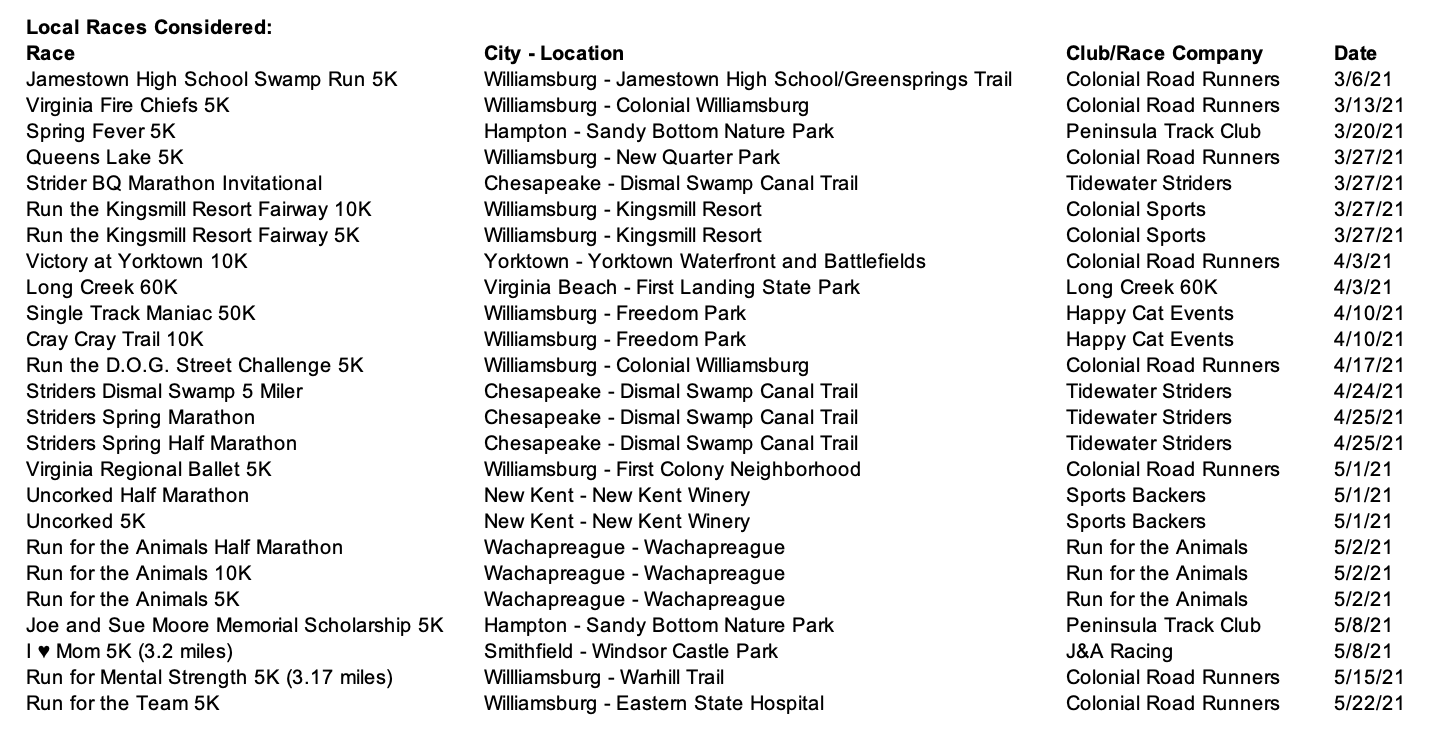Season Overview
As the world returns to relative normalcy, road racing opportunities in Hampton Roads are almost back to what they were pre-COVID. There are still some limitations and missing big events, but as I write this, most mandated precautions, including temperature checks, overall race and wave size limitations, and outdoor mask requirements are in the process of being lifted. While we missed out on some major spring events like Shamrock and One City, it appears likely that we can look forward to the return of such large races starting this summer and fall. Ushering in the return of major 757 road racing, and perhaps there is no better race to do so, is the Elizabeth River Run 10K, which with its return to Norfolk this year will kick off the upcoming summer ranking period.
First though, we have these spring rankings. Curiously, there was an identical number of local races (25) as the winter. Even more interesting, and in direct contrast to what happened last season, while the overall male rankings became significantly more competitive, the rest of the rankings categories were less competitive compared to the winter. Despite COVID, and thanks to some very agreeable weather, there were fantastic racing opportunities all winter and spring, so it’s hard to attribute these variations to anything specific. There were no spring rankings last year due to the start of the pandemic shutting everything down just as the season started, but spring 2019 is there for comparison and it is great to see the male overall category return to that pre-COVID level of quality. The other categories have a long way to go to return to their former glory, but the restoration of race opportunities and the return of some competitive COVID-dormant runners could go a long way toward achieving that.
Male Overall
Boy did the sparks ever fly atop the overall male category this spring! It started as it would finish with current William and Mary head distance coach and former track 13:37 5,000 meters and 28:35 10,000 meters runner Forest Braden getting the better of #2 Adam Otstot and #3 yours truly at the Jamestown Swamp Run 5K in a thrilling 15:41-15:49-15:54 sprint finish on the first day of the ranking period. Braden would top Otstot again, 15:21 (age grade = 86.86%) to 15:28 (85.56%), a week later at the Virginia Fire Chiefs 5K, and would top both Otstot (16:51) and me (17:16) once more at the challenging cross-country style and long-course Run for Mental Strength 5K (3.17 miles) in mid-May with his 16:50 to solidify his #1 ranking. Otstot did make a compelling argument for the top spot with his superior 15:17 (87.24%) during his win in absolutely perfect racing conditions at the Run the DOG Street 5K to go with wins at the Queens Lake 5K (15:50), Virginia Regional Ballet 5K (15:29), and Run for the Team 5K (15:23, 87.32%), but Braden’s three head-to-head triumphs were too much to overcome. Otstot’s stellar 87.32% at the Team 5K, aided by him turning 39 just a few weeks prior, is the male rankings runner-up age grade. Despite falling short to Braden and Otstot several times, I was pleased to run a debut 2:31:29 marathon (80.31%) for 2nd place at the BQ Marathon Invitational, notch a 15:30 5K PR (82.90%) at DOG Street, and pick up wins on heavy legs at the Victory at Yorktown 10K (33:38) a week after my marathon and at the Striders Dismal Swamp 5 Miler (26:54) at the back end of a 110-mile week. My streak of three seasons ranked #1 is over; we’ll see if I can bounce back later this year.
4th-ranked David “Zion” Gregory earned his spot with his pair of longer races in North Carolina, first a 1:11:50 (80.77%) winner at the Sunset Beach Half Marathon, and then a 2:35:39 marathon debut for 2nd at the Wilmington Marathon. #5 David Kidd topped Gregory’s marathon time, but not his best 10K equivalent, with his 2:34:12 negative split PR for 4th place at the BQ Marathon Invitational. 6th-ranked Emmanuel Gomez was next at BQ, finishing in 2:36:49 for 5th place. Gomez amazingly bounced back a week later to run an admirable 5:51:30 for 7th at the Long Creek 60K. #7 Jacob Warner illustrates the improved quality atop these rankings by falling 4 spots from his #3 ranking last season despite running a swift 16:11 for 4th at DOG Street, which was just a bit slower than his best winter offering. Warner also picked up the win at the Run the Kingsmill Resort Fairway 10K in a solo effort 35:22. 8th-ranked Mark Tompkins, age 45, ran a spectacular 16:20 (86.02%) for 5th place at DOG Street, making him the top master by a long shot. His 16:55 (83.05%) for 3rd at the Ballet 5K was very fast as well. #9 and Western Branch High coach Ryan Carroll helped pace Evan McCue, one of his Western Branch athletes, to a breakthrough 2nd place 16:27 (80.85%) at Queens Lake en route to Carroll’s own 16:36 (80.32%) for 3rd. Carroll also won the Lucky Charm 5K in Florida in 16:42. McCue only ran one race this spring, and could’ve made the top 10 with a second outing. Carroll makes just three returning ranked runners in the top 14 as he falls four spots from his winter #5 ranking. Rounding out the top 10, and just behind Carroll at Queens Lake in 16:39, is Blaine O’Reilly, who also ran a consistent 16:40 for 3rd at the Team 5K.
There was some tight competition just outside of the top 10, where William and Mary student Austin Alanis snagged the #11 spot just ahead of Clark Pederson. Pederson’s best 10K equivalent of 34:56 is superior to Alanis’ 35:06, as he beat Alanis by five seconds at DOG Street, 16:46 to 16:51. But Alanis beat Pederson by 10 seconds at Queens Lake (17:04-17:14), and his 17:14 at the Fire Chiefs 5K is far superior to Pederson’s 36:18 Yorktown 10K, thus earning Alanis the advantage in the rankings. One-racers John Vogel and Seth Kolosso would’ve easily made the top 5 with a second race. Vogel edged me by one second with his 15:29 for 2nd place at DOG Street, and Kolosso was next behind me in 2:33:46 for 3rd at the BQ Marathon. Kolosso was ranked #2 last season, and has now moved to Colorado where he will surely benefit from training at altitude. Another Western Branch one-racer, Lucas Simmons, ran a strong 16:17 (80.55%) for the win at the Joe and Sue Moore Memorial Scholarship 5K, and would’ve easily made the top 10 with a second race.
As mentioned in the Season Overview, the male overall ranking category was significantly more competitive than last season. Making the top 5, 10, and 25 each got over a minute harder to achieve in terms of 10K equivalent. Several very fast one-racers from the winter got at least their two races in this spring, bolstering the category to its usual pre-COVID level of quality. Thanks to COVID, there were no spring 2020 rankings for comparison, but compared to spring 2019 10K equivalents, the top 5 (sub-33:10 vs sub-34:30) and 10 (sub-34:50 vs sub-35:10) are significantly stronger while the top 25 is just somewhat weaker at sub-38:20 vs sub-37:40.
Rick Platt commentary
It’s always a bit awkward writing about yourself, but Roger Hopper is a dedicated student of the sport, puts in countless hours with the research on these seasonal rankings; and since he’s been one of the top runners in the Hampton Roads area for the past half dozen years, he has to write about himself, which he does fairly. But as editor of these rankings, assisting Roger, I’ll begin to write occasional commentary on things I find of interest within the rankings.
Roger has dominated two Grand Prix series for many years, winning six consecutive Colonial Road Runners Grand Prix titles, and five consecutive Hampton Roads Super Grand Prix titles; and with the exception of 2020 (when Williamsburg’s Will Thompson battled him throughout the year), Roger has won easily, often finishing over a minute or more ahead of his competition in CRR races. His yearly 5K bests were 15:57 in 2018 and 16:00 in 2019, before the competition with Thompson helped him get down to a 15:44 last year.
So what’s ironic in 2021 is that Roger is training harder than any time in his life, up to 140 miles per week, is in the best running shape of his life, and has set lifetime PRs at every distance from the 5K to the marathon (with the exception of his outstanding 25:21 at the 2020 Toano Icy 8K), yet instead of dominating the competition as he has since 2015, he is now only the third best runner in the CRR (behind Adam Otstot and Forest Braden, neither of whom he has beaten this year), and is only the third best runner in the Hampton Roads area. Yes, Roger likes to win, but even more he likes to compete. And the competition makes him a better runner. So he welcomes the incentive of racing with the best trio of runners in the 40-year history of the CRR. Adam has run 15:17 for 5K this year, Forest 15:21, and Roger a PR 15:30 at DOG Street. I can see all three sub-15:15 this year, and somebody might even better the magic 15-minute barrier in 2021. Stay tuned.
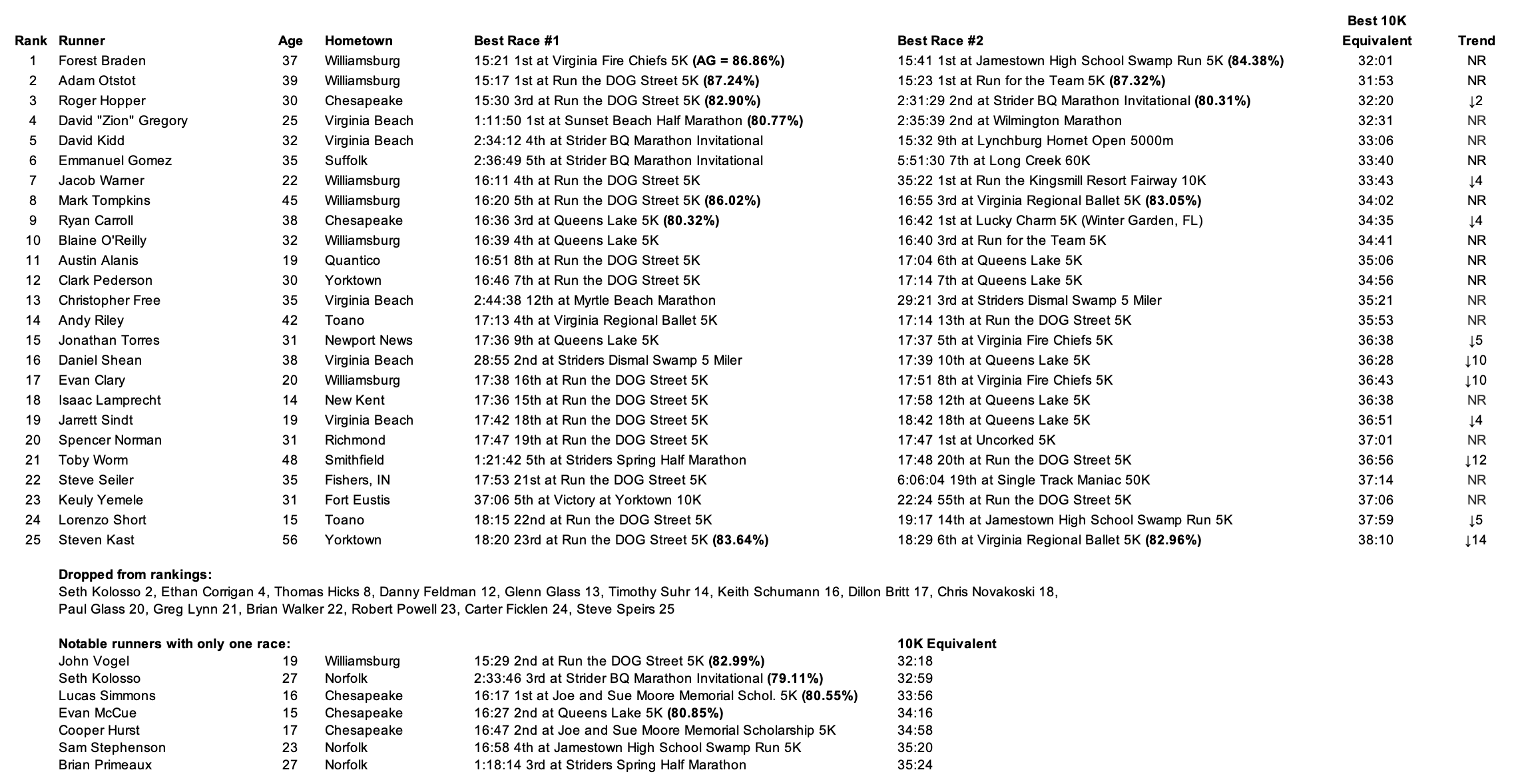
Male Masters
After both only raced once last season, #1 Mark Tompkins and #2 Andy Riley have certainly distinguished themselves while earning their rankings this spring. When he actually runs two races in a season, Tompkins is the betting favorite for top-ranked master, and he proved that yet again with a dazzling 16:20 (86.02%) at the DOG Street 5K backed up by a solid 16:55 (83.05%) at the Virginia Regional Ballet 5K. Tompkins has had the top master time during each of the past four seasons, but this spring was the first season in over a year, since his winter 2019-2020 #1 ranking, during which he ran two races to claim the top spot. Riley was #1 master in Tompkins’ one-racing absence last fall, but this season had to settle for 2nd despite his outstanding 17:13, just 18 seconds behind Tompkins, at the Ballet 5K, to go with his 17:14 at DOG Street.
Over a 10K equivalent minute back from Riley is 3rd-ranked Toby Worm, down one spot from last season despite his strong 1:21:42 at the Striders Spring Half Marathon. Worm leads a string of eight returning ranked master men from the winter, and is one of 14 ranked male masters with one of his top two races coming at DOG Street, where he ran 17:48. #4 Steven Kast also took advantage of perfect racing conditions at DOG Street to run his best time of 18:20 (83.64%), as did 5th-ranked Greg Lynn with his 18:29. Kast topped Lynn again at the Ballet 5K, 18:29 to 18:43, to secure his superior spot. Like Worm, Kast fell one spot compared to last season. Much less obvious than Kast’s advantage over Lynn was Lynn’s competition with #6 Jason Miller. Lynn and Miller had identical top 5K times of 18:27, Lynn at DOG Street and Miller at the Virginia Fire Chiefs 5K. Lynn crushed Miller at DOG Street, 18:27-19:55, on what must’ve been an off day for Miller after his convincing 18:27-18:48 victory over Lynn at Fire Chiefs. A week prior to Fire Chiefs, Lynn had beaten Miller 18:51 to 19:06 at the Jamestown Swamp Run 5K. Lynn also edged Miller 18:43-18:44 at the Ballet 5K, and so Miller’s 18:44-19:16 advantage at the Run for the Team 5K on the last day of the ranking period was just not enough in this back-and-forth competition. Still, Miller moves up six spots from his #12 master ranking last season.
Just behind Miller by one 10K equivalent-second, but also definitively behind Miller thanks to Miller’s 18:27-18:44 head-to-head victory at the Fire Chiefs 5K, is Timothy Suhr, who fell 3 spots from last season to his #7 ranking here. Suhr’s best race came at the Striders Spring Half Marathon, where he ran 1:25:01 to finish just over a minute ahead of 9th-ranked Peter Pommerenk, who ran 1:26:07 and improved his ranking by one spot compared to the winter. #8 Steve Speirs was almost eight minutes ahead of Pommerenk, 2:59:27-3:07:25, at the Strider BQ Marathon Invitational, where he kept his incredible 17-year sub-3 hour marathon streak alive. There was a very close competition, at #10 and #11, in what is another classic battle between two of Hampton Roads’ strongest age-graded runners, Robert Whitaker and Stephen Chantry. Whitaker’s best time 18:45 (86.13%) at age 62 just edged Chantry’s best time 18:46, but the 66-year-old Chantry scores a jaw-dropping spring-rankings-high age grade of 89.17%. Both of these top times came at DOG Street. Whitaker also edged Chantry at Queens Lake (18:55-19:04), the Victory at Yorktown 10K (40:36-41:24), and the Run for the Team 5K (19:10-19:18), while Chantry topped Whitaker at the Swamp Run 5K (19:44-19:45) and the long- and slow-coursed Run for Mental Strength 5K (3.17 miles) (20:55-21:13). Whitaker’s four head-to-head victories to Chantry’s two give him the narrow edge here. Despite being senior grand masters, Whitaker and Chantry impressively make the masters top 11, and of course top the 60+ category as well. Whitaker did great to improve his masters ranking by eight spots compared to last season, while Chantry only ran one race over the winter. A couple of masters Striders Spring Half Marathon runners, Edward Rietscha (1:21:59) and Eric Berge (1:22:49), finished behind Worm and in front of Suhr at that race and could’ve made the top 5 on this list, but they only raced once this season.
Making the top 5 (10K equivalent of 38:20 or better) and top 10 (sub-39) was similar this spring compared to last season, but making the top 25 got about a minute-and-a-half easier, going from sub-42 to just sub-43:30. There were no spring 2020 rankings due to COVID, but compared to the spring 2019 thresholds of a sub-36:50 top 5, sub-38 top 10, and sub-40 top 25, the current crop of Hampton Roads masters men have a lot of work to do to compete with their previous levels. The entire top 25 from two years ago would make the top half of this spring’s list. There are a few notable names missing from this spring’s rankings compared to 2019; perhaps with the abating of COVID and return of bigger races that level of quality will make a return this summer.
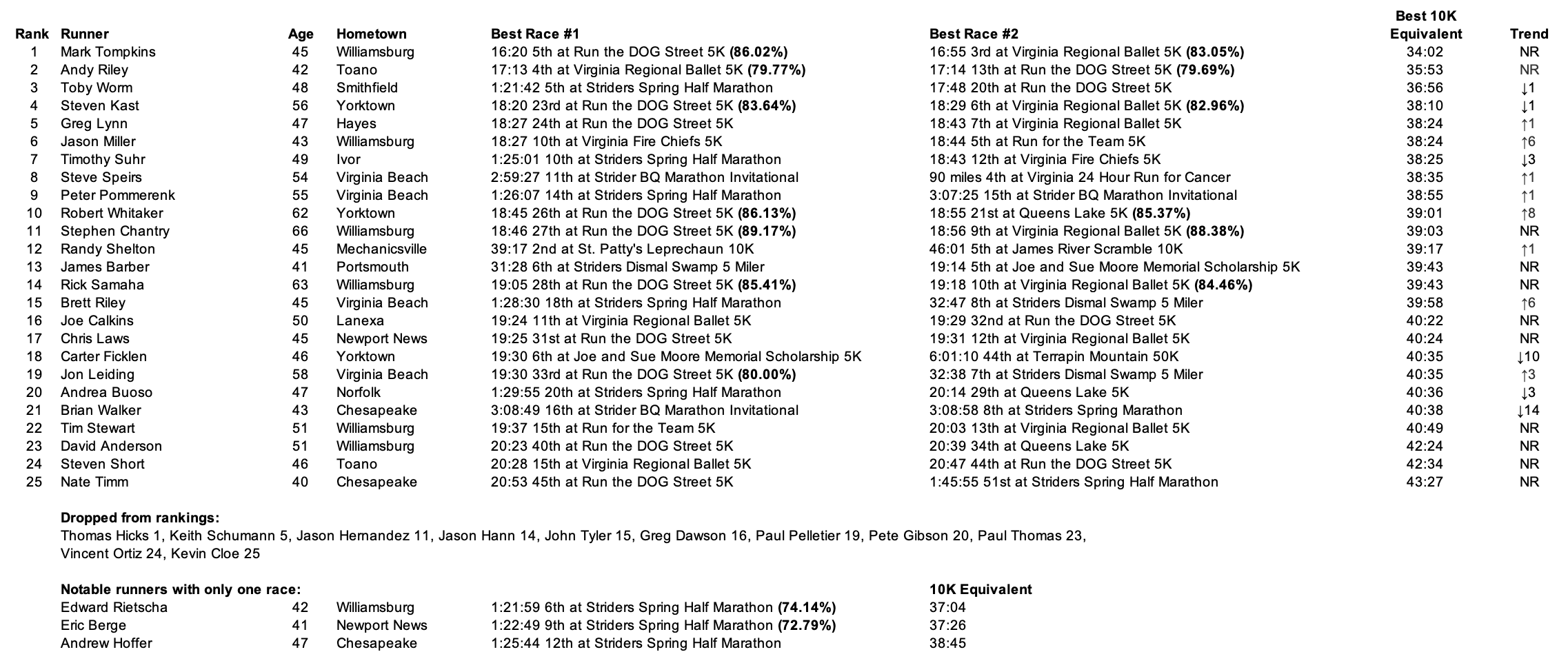
Male 60+
There is no doubt about the top 3 in this category, as living legends Robert Whitaker, Stephen Chantry, and Rick Samaha all achieved sub-40 10K equivalents and are head and shoulders above their peers age 60 and older. Each of these three defeated the other two in a race at some point this season, but Whitaker replicates his #1 ranking from this past winter, and for a full breakdown of the close competition between him and Chantry, see the third paragraph of the male masters category summary above. This trio’s top times compared well even to those up to two decades younger than them, as they were ranked 10th (Whitaker), 11th (Chantry), and 14th (Samaha) in the masters category, but here they absolutely dominate, clearing any other competition by over four 10K equivalent minutes. They finished in that order in pristine racing weather at the DOG Street 5K, taking advantage of the perfect conditions to run their season-best times of 18:45 (age grade of 86.13%), 18:46 (rankings-high 89.17%!), and 19:05 (85.41%), respectively. I would be remiss to not mention that while Samaha is ranked 3rd out of these three, he did top both Whitaker and Chantry at the Jamestown Swamp Run 5K and beat Whitaker at the Fire Chiefs and Run for Mental Strength 5Ks, but Whitaker and Chantry had more than enough victories over Samaha for the rankings to fall as they are.
All of that praise heaped on the top 3 doesn’t take anything away from #4 67-year-old Richard Grant, of course, who ran a fantastic 34:44 at Striders Dismal Swamp 5 Miler on another morning with great racing weather. Grant, who was five seconds ahead of 6th-ranked Jim Duffy at DOG Street, fell just one spot from #3 last season. Just behind Grant is #5 Michael O’Hara, who impressed with his pair of half marathons, 1:37:18 at the Striders Spring Half and 1:38:32 for 3rd at the Run for the Animals Half. Down two spots from the winter is #6 Duffy, who turned in another remarkable DOG Street performance by running 21:13 at age 68 for an age grade of 80.36% en route to beating 7th-ranked Tom Clark's 21:24 by a mere 11 seconds. Clark managed to run two seconds faster than his DOG Street time at the Virginia Regional Ballet 5K to earn his spot. After Clark at 44:26 is a long, almost two 10K-equivalent-minute drop to #8 Ken Alberg at 46:22. Clark beat Alberg by well over a minute, 21:22 to 22:44, at the Ballet 5K. Alberg then beat 9th-ranked Tom Robinson by almost a minute at the Team 5K, 22:17-23:15, overcoming his two-second defeat at Robinson’s hands at the Ballet 5K, 22:42-22:44, to claim the higher ranking. Robinson improves one spot from #10 last season. Closing out this season’s top 10 is Tom Barry, who turned in yet another great DOG Street performance in 22:51.
Just outside the top 10 is another pair of very closely-ranked runners. 12th-ranked Timothy Hodge beat #11 and top septuagenarian Dale Abrahamson by 10 seconds, 23:23 to 23:33, at Queens Lake, but then Abrahamson bounced back to defeat Hodge handily, 50:20 to 51:15 at the Victory at Yorktown 10K, and narrowly, 23:03 to 23:05 at DOG Street, earning his edge in the rankings. Hodge moves up an impressive 13 spots in the rankings compared to the winter, while, despite topping Hodge, Abrahamson fell three spots. There was only one particularly fast one-racer in this category this season, and that was Jim Thornton, whose 22:21 at the Run for the Team 5K would’ve scored him a #9 ranking had he run another race.
In its second season, the male 60+ category improved quite a bit up top while significantly decreasing in quality at the bottom, compared to its inaugural one. Making the top 5 got over one-and-a-half 10K equivalent minutes harder, while making the top 10 improved by a minute from sub-48:30 to sub-47:30 making the cut. This was largely thanks to some very talented one-racers from last season racing twice and making the top 10 this time. Conversely, top 25 quality dropped by almost three minutes from #25’s 10K equivalent of 51:32 to 54:26. Six ranked runners from last season’s #18-#24 dropped; their return next season would go a long way toward strengthening up this category.
Rick Platt commentary
Similar to the “Big Three” in the men’s open category, there’s another Big Three for the men’s 60-and-over rankings — Steve Chantry, Rob Whitaker and Rick Samaha. What is almost shocking is that Chantry this year has age graded a spring rankings best of 89.17% (just a shade under the world-class level of 90%) with his Virginia state record of 18:46 for men 65-69 at DOG Street (before Chantry started breaking the state record, the 65-69 mark was just 19:53, over a minute slower, a remarkable improvement), and he was almost as fast at the First Colony 5K two weeks after DOG Street with a time of 18:56, age grading 88.38%, the second best age grade for the spring rankings.
Yet with the two best age grades of any runner for the spring, and a Virginia state record to boot, Chantry was not even the #1 ranked runner for men 60+ in these rankings, losing by a razor-thin margin to friend and teammate Rob Whitaker. And Rick Samaha (who beat the other two at the Jamestown Swamp Run) was not far behind, all three with 10K equivalents in the 39s, over four minutes ahead of the next best 60+ runner. Amazing!
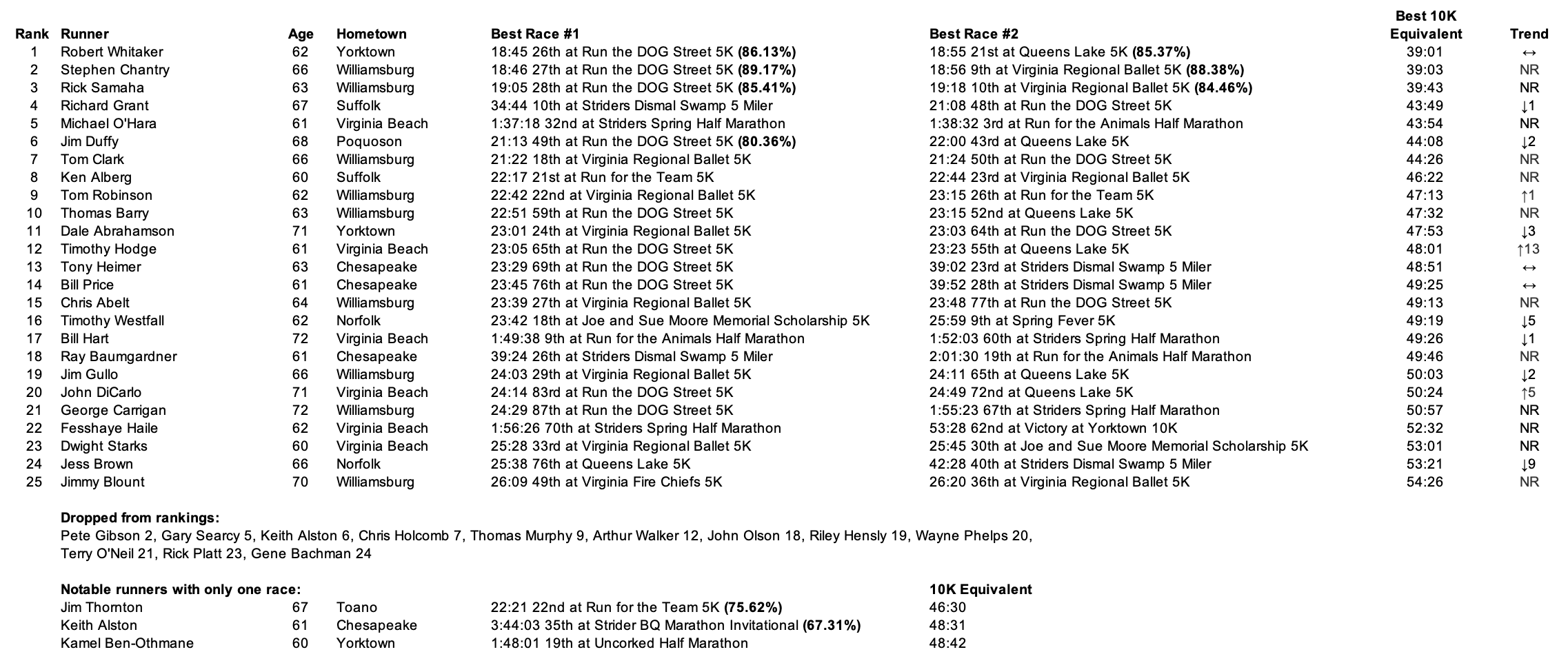
Female Overall
On one hand, the top 4 overall females from the winter didn’t race enough to get ranked, but on the other, #1 Bethany Spector’s top time of 18:27 at the DOG Street 5K was the best female time of this season and last. Spector moves up from her #5 ranking last season, and it was important that her DOG Street performance was so compelling, as while she did top 2nd-ranked Maria Spady by 17 seconds at DOG Street, Spady topped Spector by double the time over double the distance, 39:55-40:29, at the Victory at Yorktown 10K. These two head-to-head matchups being essentially equal, Spector’s superior overall 10K equivalent time takes the cake, but this is about as razor-thin a margin as you can get. To Spector’s credit, Spady only ran those two races, while Spector’s 20:05 win and the Jamestown Swamp Run 5K and 19:30 for 2nd at the Queens Lake 5K solidify her top female ranking. Spector’s 79.86% age grade for her DOG Street run is the female-rankings-high, making this season the first time no local female acheived an 80% national class age grade in the history of these rankings, which currently go back to winter 2018-2019.
#3 Emily Honeycutt saved her best for last as she recorded her top time, a PR 19:40, to win the Run for the Team 5K on the last day of the spring ranking period. Honeycutt also ran fast at DOG Street, where her 19:45 was surprisingly only good for 8th place in that very competitive race. 4th-ranked Paige Mita had the second-fastest local female marathon of the spring, 3:10:45 for 5th at the Strider BQ Marathon. Winter #1 Stephanie Rice was significantly faster at 2:59:35 to win that race, but that was her only race of the spring. Mita did however have the best 60K of the spring, running 6:36:52 just a week after BQ to win the Long Creek 60K. Jessica Smith rounds out the top 5 with her strong 1:31:24 for 6th at the Strider Spring Half Marathon. She was also 2nd at the long-course I ♥ Mom 5K (3.2 miles) in 22:22 behind one-racer and Best of 2019 #4 Megan Lindstedt’s 21:50.
6th-ranked Gwen Riley improves one spot from her ranking last season with her 42:13 for 5th at the Yorktown 10K. Riley’s best 10K equivalent is inferior to #7 Svetlana Goncharova’s, but Riley beat Goncharova head-to-head 42:13-42:59 at Yorktown. Goncharova displayed amazing steady 5K improvement all spring long. Her 5K progression over two-and-a-half months, after a 2020 PR of 21:53 in November, was 21:33 (Swamp Run) to 21:10 (Fire Chiefs 5K) to 20:37 (Queens Lake) to 20:21 (Ballet 5K) to 20:29 (Joe and Sue Moore Memorial Scholarship 5K) to 20:10 (Team 5K). Like Honeycutt, she saved her best for last by running 20:10 at the Run for the Team 5K on the last day of the ranking period. She even beat Honeycutt, 21:16-21:41, for the win at the hilly and long-course Run for Mental Strength 5K (3.17 miles), though Honeycutt won their matchup on six other occasions throughout the season. Goncharova moves up six spots from her #13 ranking over the winter. Goncharova topped 8th-ranked Sorenna Jean at Jean's two spring races, the Team 5K, where Jean ran 20:27, and the Mental Strength 5K, where Jean ran 23:48. Jean holds steady at her #8 ranking from the winter. 9th-ranked Kara Woody was just 15 seconds back of Riley at the Striders Spring Half Marathon, and topped #10 Megan Schulze by 30 seconds, 20:40-21:10, at Queens Lake, giving her the edge over Schulze in the rankings despite Schulze’s superior 10K equivalent time from her DOG Street 20:28. Schulze moves up four spots from last season. Like the Overall Men, we have another close competition just outside the top 10 where #11 Cannon Jean narrowly claims her spot despite her inferior 21:10 to 12th-ranked Meaghan Gsell’s 21:02, both at DOG Street, as Jean beat Gsell 21:21-22:38 at Queens Lake and 21:54-22:26 at the Swamp Run 5K, though Gsell did best Jean 45:51-48:14 at Yorktown to make this a very close competition. Cannon, Sorenna’s younger sister, improves a nice eight spots from the winter rankings.
As mentioned above, winter #1 Stephanie Rice only ran one race this spring, but it was a great one as she won the BQ Marathon in 2:59:35. Her and Sika Henry, with her 18:43 win at Queens Lake, would’ve easily been in the top 3 with a second race, but would’ve been hard-pressed to top #1 Spector. The next two finishers at DOG Street after #2 Spady, 6th place Rachel Parthasarthy (19:01) and 7th Tiffany Sloan (19:37), as well as Strider Spring Half racers Mollie Sweet (1:28:45) and Kelly Anne Kennedy (1:30:45), all could’ve made the top 5 with another race. Sweet and Kennedy were 4th and 5th at the Half, respectively, just ahead of 6th place and 5th-ranked Smith. Last season’s 2nd-ranked female, Jenny Moran, ran 20:01 at Queens Lake for her only race and would’ve been #6 with another effort.
Compared with the winter, the spring female overall rankings are a mixed bag. Making the top 5 dropped in quality from a 10K equivalent of sub-40:30 to sub-41:15, while the top 10 held steady at sub-42:40 to make the cut, though the drop from the top 10 to #11 is quite sizeable at over a 10K equivalent minute. The top 25 suffered the most, dropping from sub-47:40 to sub-49. There were no spring 2020 rankings due to COVID, but compared to spring 2019 these rankings are massively down, particularly when it comes to making the top 25, which was over four-and-a-half minutes easier to make this spring than two years ago.
Rick Platt commentary
I've been coaching Sveta (Svetlana Goncharova) since mid-January, and while I’ve coached many runners over the past 35 years, I've even been surprised at her rapid rate of improvement in just over four months, from a 2020 PR of 21:53 for 5K, and steadily down to a 20:10 in May, from 36:20 to 33:05 for the 8K, and from 46:49 to 42:53 for the 10K, along with running her first half marathon (Colonial). Yet she remains a very low mileage runner, in contrast to her Colonial Road Runners Grand Prix friend and rival Emily Honeycutt (after 10 races Emily currently leads the CRR GP with 74 points, to 61 for Sveta; and 50 for spring rankings leader Bethany Spector, who has run two fewer CRR races). Emily trains about 45 miles a week and runs every day, Sveta does about half that distance, and averages just 3 or 4 workouts a week. Continued improvement is certainly likely as she ups her training for the summer and fall racing seasons.
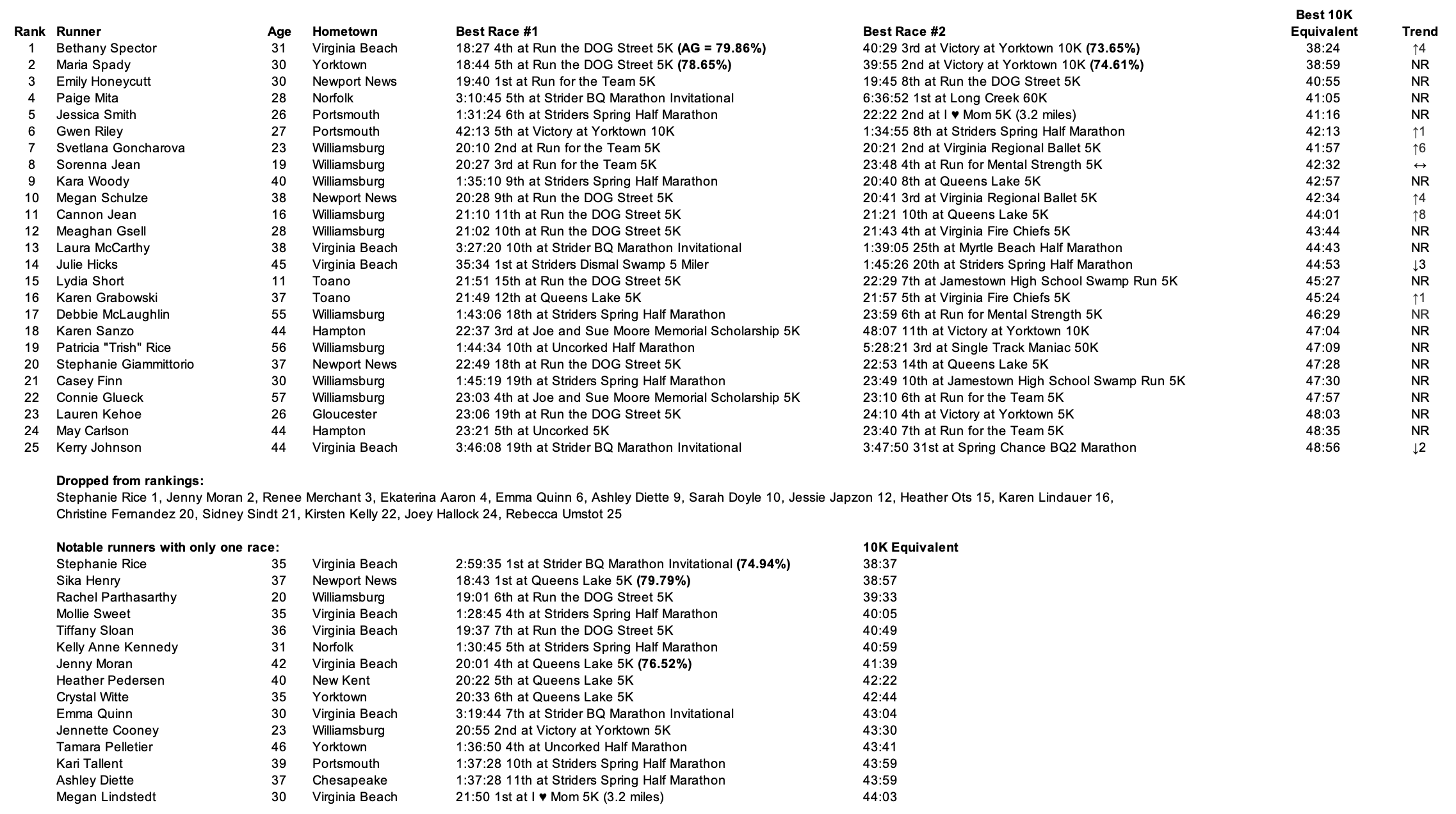
Female Masters
After three seasons at #1, Jenny Moran’s reign as top female master came to an end as she uncharacteristically only ran a single race. Swooping in to take over in her absence is fledgling master Kara Woody, whose superb 1:35:10 Striders Spring Half Marathon puts her almost two 10K equivalent minutes ahead of the rest of the field. This is backed up by her 20:40 at the Queens Lake 5K, where she finished 39 seconds back of Moran’s solid 20:01. 2nd-ranked, and clear of the rest of the field by almost another two minutes, is Julie Hicks, who replicates her #2 ranking from the past three seasons on the strength of her 35:34 victory at the Striders Dismal Swamp 5 Miler. #3 is Debbie McLaughlin, who leads three women age 55 and over in the top 6 with her 1:43:06 Striders Spring Half Marathon. 4th-ranked Karen Sanzo’s 22:37 for 3rd at the Joe and Sue Moore Memorial Scholarship 5K narrowly edges out #5 Patricia “Trish” Rice’s 1:44:34 Uncorked Half Marathon. 6th-ranked Connie Glueck was next behind Sanzo at the Memorial Scholarship 5K in 23:03, and topped #7 May Carlson at the Run for the Team 5K, 23:10-23:40. Carlson’s best time came at the Uncorked 5K, where she ran 23:21.
8th-ranked Kerry Johnson leads a string of five returning ranked female masters with her pair of spring marathons, first the Strider BQ Marathon in 3:46:08 on March 27th, and then the Spring Chance BQ2 Marathon three weeks later in Geneva, Illinois in 3:47:50. Johnson falls two spots from her winter #6 ranking. 9th-ranked Kelly Russo was over 13 minutes back from #1 Woody, but only three-and-a-half back from #2 Hicks, at the Strider Spring Half Marathon in 1:48:53, and moves up five spots from last season thanks to this effort. #10 Kirsten Kelly opted for the marathon that morning, dropping a best time of 3:48:50 at the Striders Spring Marathon, almost nine minutes ahead of 11th-ranked Magaret Kopacz's 3:57:40. Kopacz flipped the script at her best and Kelly's second-best race at the Striders Dismal Swamp 5 Miler, where Kopacz beat Kelly by four minutes. Having split the head-to-head competition fairly evenly, Kelly gets the nod in the rankings thanks to her superior best 10K equivalent. Kopacz is tied for top climber on this list, up seven spots from her winter #18 ranking, while Kelly fell five spots from her #5 ranking last season.
As mentioned above, Jenny Moran only ran one race this season, and her 20:01 at Queens Lake would’ve been good for #1 had she run another race. She wasn’t the only one though, as Heather Pedersen also could’ve snagged the top spot with a second race on the strength of her 20:22 at Queens Lake, next across the finish line after Moran. Tamara Pelletier’s 1:36:50 Uncorked Half could’ve seen her claim the #2 ranking with a second effort, and just behind her are three other one-racers, all from the Striders Spring Half Marathon, who would’ve made the top 3 with another race, including last season’s #2 Karen Lindauer in 1:41:02.
Compared to the winter, the masters women rankings took a small step back this spring. The cutoff for the top 5 actually improved, thanks to four newly-minted ranked runners up top, going from a 10K equivalent of 47:19 to 47:09, but the top 10 went from 48:52 to 49:34, and the top 25 went from 52:39 to 53:33. Not bad, but plenty of room for improvement. Compared to the last pre-COVID spring rankings in 2019, we’re quite a bit further behind as the top 5 was 44:26, top 10 46:06, and top 25 49:05. The entire top 25 from spring 2019 would’ve easily made this year’s top 10. With all the excitement about big races coming back, and a big handful of fast one-racers this season, I have no doubt this category will make a comeback as well.
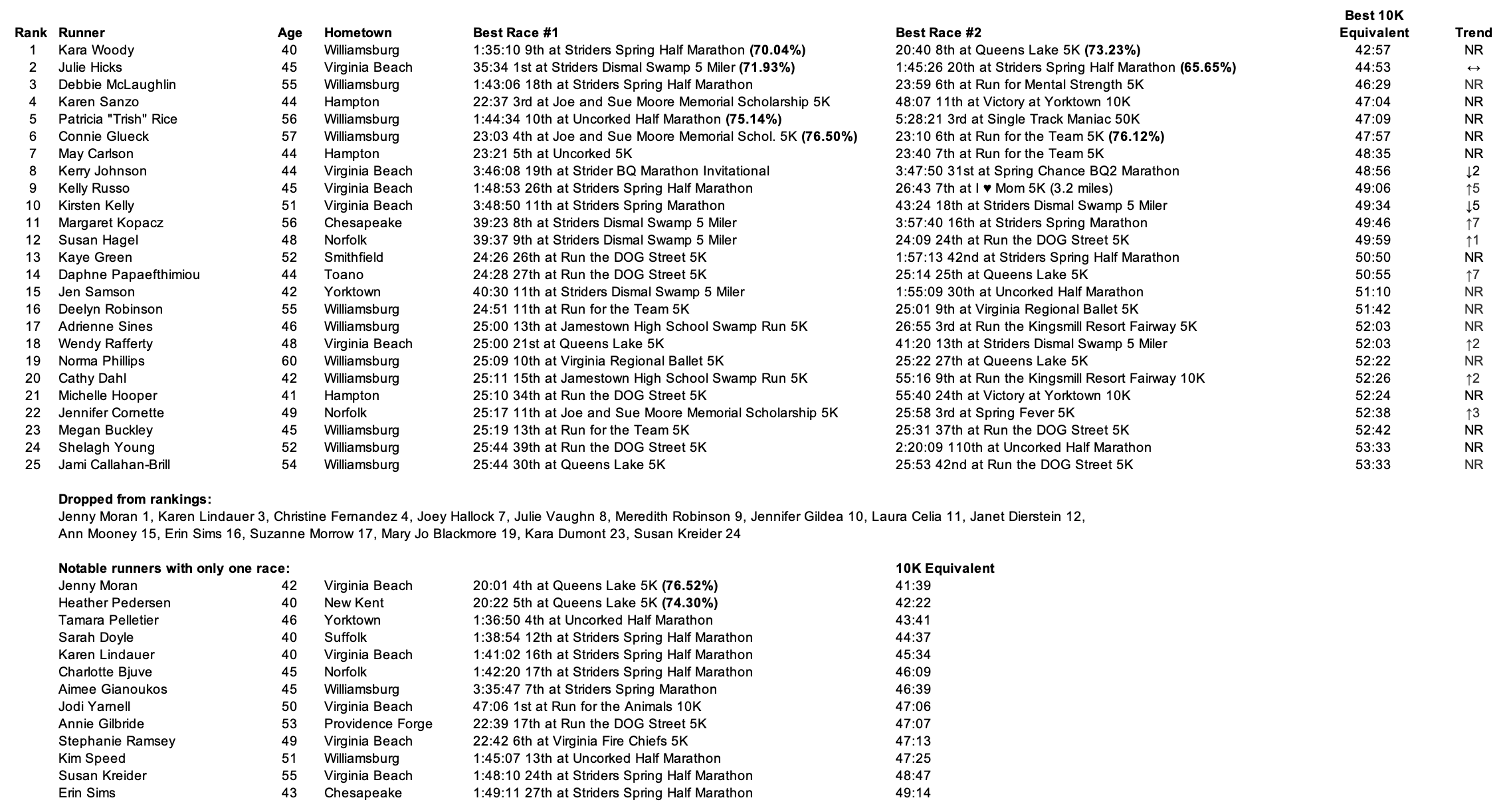
Female 60+
It was great to see 8 of the top 10 return in this category, including the winter’s #2 Norma Phillips claiming the top spot in the absence of last season’s #1, Joey Hallock. Phillips tops the category by a massive margin of over four 10K equivalent minutes at 52:22 for her outstanding 25:09 10th-place effort at the Virginia Regional Ballet 5K, and only the top 4 even broke the hour mark. 2nd-ranked Helen Worthington improves her winter ranking by three spots on the strength of her 27:11 at the DOG Street 5K, where she beat #4 Patricia Travis, #5 Jan Barry, and #6 Shirley Stephens. Janice Kailos also beat Barry and Stephens, this time at Queens Lake, with a 27:40 to claim the #3 spot on this list. Travis’ best time came at the Ballet 5K, where she did 28:30. She also beat Barry and Stephens at DOG Street. Like Kailos, Barry and Stephens’ best times came in good weather on the fast Queens Lake course, 29:22 and 29:54, respectively. That pair also finished in that order at DOG Street, Barry 29:37 and Stephens 30:03. 7th-ranked Martha Gullo was a couple minutes back of Travis at the Ballet 5K in 30:41, but her best time came at the Joe and Sue Moore Memorial Scholarship 5K in 30:17.
There were no less than 10 one-race runners who could’ve made the top 5 with another race. Mary Jo Bailey could’ve taken it all with her 24:39 at DOG Street, and Maria Jacob leads five others with #2 potential given her 1:58:13 at the Striders Spring Half Marathon. Last season’s #3, Mary Lynch, was just over four minutes behind Jacob at that Half in 2:02:30. In a surprising turn of events, Williamsburg women dominate this category with seven in the top 8, in contrast to the winter when there were just five in the top 15.
This category took a huge step backwards as the top 5, 10, and 15 all got over five 10K equivalent minutes easier to qualify for. With a small pool of talented runners to pull from, the quality of this list was drastically affected by a few missing big names. With more racing opportunities and less COVID concern than there has been in over a year, this summer promises to be a good one, and hopefully there will be enough female super grand masters to put together a full top 25.
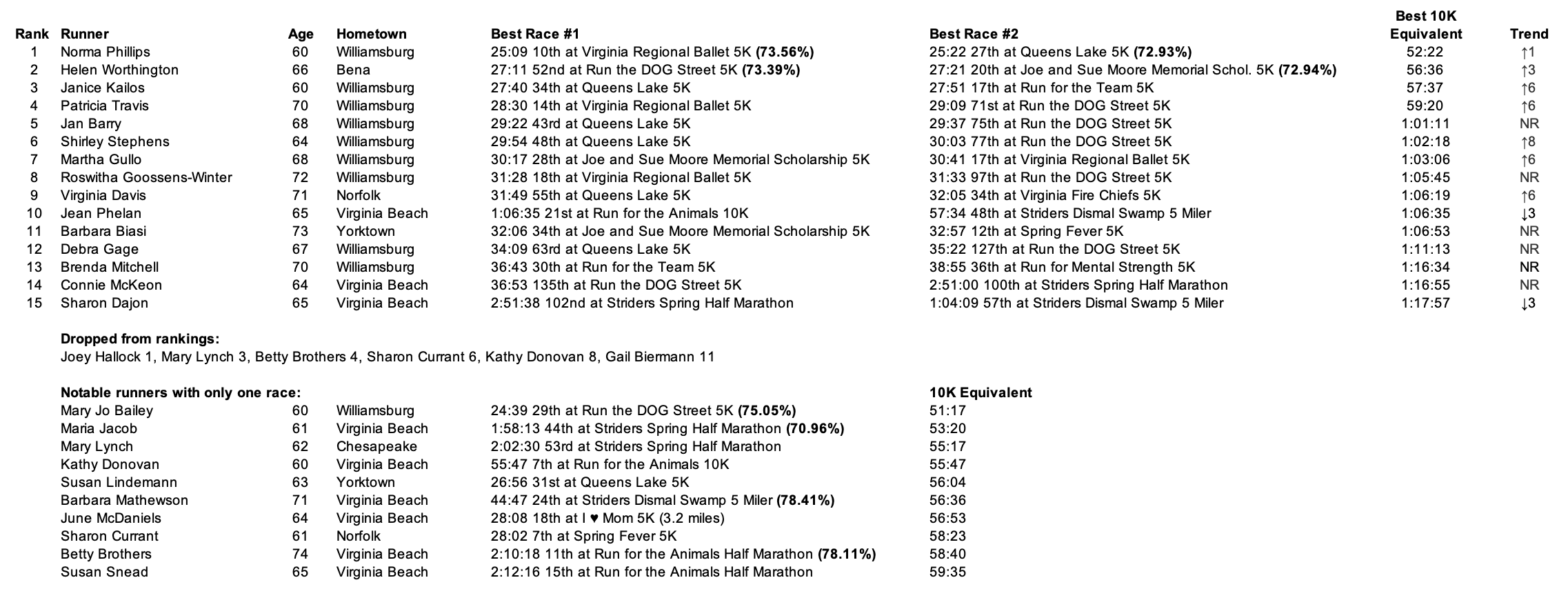
Races
In order to be considered for these rankings, a race must have open entry to all, have full results listed on a website, and preferably list age, gender, and city of residence of all runners. Road and cross country races will be considered. Any race that is known to have an actual distance significantly different from its advertised distance will have its actual, or more accurate best-guess, distance displayed in parentheses. Races will fall into the following seasons based on the following boundaries: spring is the first full weekend of March up to but not including Memorial Day weekend, summer includes Memorial Day weekend through Labor Day, fall is from after Labor Day to before Thanksgiving, and winter includes Thanksgiving races up to but not including the first full weekend of March.
